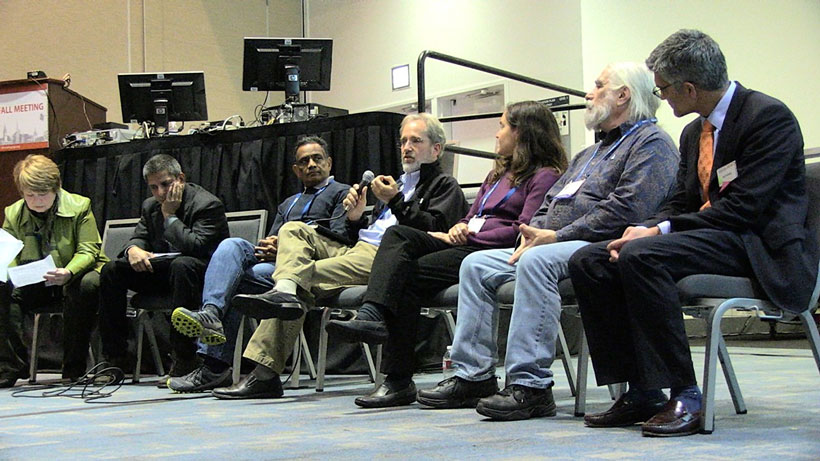The American Geophysical Union’s (AGU) Thriving Earth Exchange (TEX) builds collaborative relationships between community leaders, scientists, and sponsors and helps them design and implement local solutions. TEX is driven by local communities and their real-world issues with natural hazards, natural resources, and climate change.
TEX held three events at the 2014 Fall Meeting. Together, they provided participants an opportunity to learn, practice, and be inspired by community science.
Community Science in Organizations
TEX kicked off its programming at the 2014 Fall Meeting with a session on 16 December on the theory of community science within a range of organizations (click here for the virtual telecast).
Speakers included Roger Pulwarty, of the National Oceanic and Atmospheric Administration; Ramakrishna Nemani, of NASA; Bob Gough, of the Intertribal Council on Utility Policy; and Julie Maldonado, of the U.S. Global Change Research Program. Addressing the challenges for scientists working in an unfamiliar context, Gough joked that community science with indigenous communities was “something anyone can do if they are willing to spend three generations learning the culture.” Gough also emphasized patience, something all the panelists agreed was essential.
Another key message was that scientists need to work with community members to define the problem and imagine solutions rather than coming in with a predefined solution. One example highlighted was the case of Rawalpindi, Pakistan, which is adapting to more frequent flooding events associated with climate change by treating sewage. While it doesn’t prevent flooding, sewage treatment prevents the negative health impacts associated with flooding, which residents identified as their primary concern.
A Focus on Neighborhood Resilience

At a hands-on TEX workshop on 18 December, San Francisco County Director of Neighborhood Resilience Daniel Homsey offered advice on how to begin a community discussion that could lead to community science projects. He proposed that community members and scientists start with a satellite view of the neighborhood to get residents thinking about what kind of actions they could take to ensure that their community could maintain power, water supplies, and communication if they were cut off from the outside world.
This method of planning is important because it gets people working together, integrates diverse viewpoints, and situates scientists and their knowledge as allies and partners rather than outside experts. It also introduces the concept of risk into the process of finding solutions, which is novel and potentially more effective in bringing about change and empowering communities. People interested in using this approach in their own community can find more information at San Francisco’s Neighborhood Empowerment Network website.
Personal Stories from Scientists and Community Members
At an 18 December networking reception, attendees heard firsthand, through 5-minute “lightning” talks, about the experiences of scientists and community members and their passion for developing community science projects.
Scott Dobler, of Western Kentucky University’s Mesonet, a network of automated meteorological stations, talked about the value of codesigning tools with water managers, a process that has led to the development of tools that are quite different from what the scientists imagined.
Linda Smith, of Filters for Families, a nonprofit based in Colorado, talked about how much water on the Pine Ridge Reservation in South Dakota is unsafe or untested. She discussed how she works with cancer survivors to test and treat the water.
LaShonn Billingsley, a Denver community leader in the resident-led research cooperative Taking Neighborhood Health to Heart, said communities want scientists as partners because “we don’t even know what we don’t know. We need scientific input, and scientists have to walk the line between deferring to community members and dominating the discussion, and vice versa,” she said.
Karim-Aly Kassam, who has been working with villages in the Pamir Mountains of Afghanistan and Tajikistan to help them adapt to a changing climate, also presented a lightning talk at TEX’s networking reception. Kassam and his team of researchers at Cornell University have been studying the region for more than 10 years. He suggested using the latest climate science to help adapt and update ecological calendars in the Pamir Mountains, because an approach that respects traditional practices is more likely to be successful than one that seeks to replace them. As for working in such a challenging place, Kassam said, “It is precisely because the challenges are so large in this region that we are compelled to work there.
From Talk to Action
Currently, the Pamir Mountains discussion is hosted on Massachusetts Institute of Technology’s Climate Colab , which offers a space for community members and experts to create, analyze, and select actionable proposals to address climate change. Anyone can submit an idea by selecting the “Create Proposal” button, or people can participate in ongoing discussions around existing ideas or the general concept itself. All AGU members are invited to explore the concept on Climate Colab.
The networking reception was a huge success and reflected the kind of connections TEX would like to foster online.
Thank You
TEX extends a hearty thank you to all of those who supported our Fall Meeting events in San Francisco. All of our events were a great success, due, in large part, to the talented people who spoke and to the passionate people who attended.
—Natasha Udu-gama, Director of Community Partnerships, Science, AGU; email: nudu-gama@agu.org; and Raj Pandya, Program Director, Science, AGU
Citation: Udu-gama, N., and R. Pandya (2015), Thriving Earth Exchange hosts community science in action events, Eos, 96, doi:10.1029/2015EO023453. Published on 6 February 2015.
AGU Thanks Fall Meeting Sponsors
Text © 2015. The authors. CC BY-NC 3.0
Except where otherwise noted, images are subject to copyright. Any reuse without express permission from the copyright owner is prohibited.

